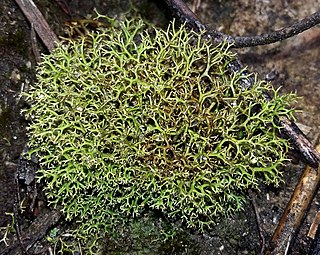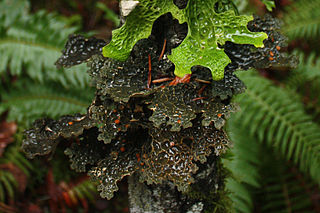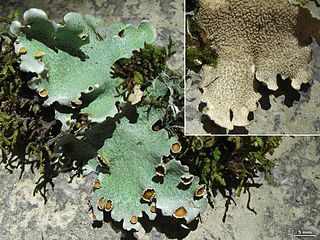
Parmelia is a genus of medium to large foliose lichens. It has a global distribution, extending from the Arctic to the Antarctic continent but concentrated in temperate regions. There are about 40 species in Parmelia. In recent decades, the once large genus Parmelia has been divided into a number of smaller genera according to thallus morphology and phylogenetic relatedness.

Lobaria is a genus of foliose lichens, formerly classified in the family Lobariaceae, but now placed in the Peltigeraceae. They are commonly known as "lung wort" or "lungmoss" as their physical shape somewhat resembles a lung, and their ecological niche is similar to that of moss.

The Peltigeraceae are a family of lichens in the order Peltigerales. The Peltigeraceae, which contains 15 genera and about 600 species, has recently (2018) been emended to include the families Lobariaceae and Nephromataceae. Many Peltigeraceae species have large and conspicuous, leathery thalli. They largely occur in cool-temperate to tropical montane climates. Tripartite thalli involving fungus, green algae and cyanobacteria are common in this family.

The Collemataceae are a lichenized family of fungi in the order Peltigerales. The family contains ten genera and about 325 species. The family has a widespread distribution.

Sticta is a genus of lichens in the family Peltigeraceae. The genus has a widespread distribution, especially in tropical areas, and includes about 114 species. These lichens have a leafy appearance, and are colored brown or black. Sticta species with cyanobacteria as photobionts can fix nitrogen from the atmosphere, and due to their relative abundance and high turnover, they contribute appreciably to the rainforest ecosystem. They are commonly called spotted felt lichens.

Cladia is a genus of lichen-forming fungi in the family Cladoniaceae. Cladia species have a crustose or squamulose (scaly) primary thallus and a fruticose, secondary thallus, often referred to as pseudopodetium. The type species of the genus, Cladia aggregata, is widely distributed, occurring in South America, South Africa, Australasia and South-East Asia to southern Japan and India. Most of the other species are found in the Southern Hemisphere.

Myelochroa is a genus of foliose lichens in the family Parmeliaceae. They are commonly known as axil-bristle lichens. It was created in 1987 to contain species formerly placed in genus Parmelina that had a yellow-orange medulla due to the presence of secalonic acids. Characteristics of the genus include tightly attached thalli with narrow lobes, cilia on the axils, and a rhizinate black lower surface. Chemical characteristics are the production of zeorin and related triterpenoids in the medulla. Myelochroa contains about 30 species, most of which grow on bark. The genus has centres of distribution in Asia and North America.

Pseudocyphellaria is a genus of large, leafy lichens that are sometimes referred to as "specklebelly" lichens. The genus has a widespread distribution, especially in south temperate regions, and contains about 170 species. They resemble Lobaria, except that most species of Pseudocyphellaria have conspicuous pseudocyphellae on their lower surface, a characteristic that was once considered unique to this genus. Some species contain pulvinic acid-related pigments; in these species the soredia and pseudocyphellae can be bright yellow.

Imshaugia is a genus of seven species of foliose lichens in the family Parmeliaceae. They are commonly known as starburst lichens.

Anzia is a genus of foliose lichens known as black-foam lichens in the large family Parmeliaceae. It was formerly included in the monogeneric family Anziaceae, but this has since been subsumed into the Parmeliaceae.

Punctelia borreri is a species of foliose lichen in the family Parmeliaceae. It is a common and widely distributed species, occurring in tropical, subtropical, and temperate regions of Africa, Asia, Europe, North America, Oceania, and South America. The lichen typically grows on bark of deciduous trees, and less commonly on rock. Some European countries have reported increases in the geographic range or regional frequency of the lichen in recent decades, attributed alternatively to a reduction of atmospheric sulphur dioxide levels or an increase in temperatures resulting from climate change.

Parmelia fraudans is a species of foliose lichen in the family Parmeliaceae. It is found in Europe and North America, where it grows on rocks.
Yoshimuriella is a genus of foliose (leafy) lichens in the family Peltigeraceae. It has nine species.

Pseudocyphellaria glabra is a species of corticolous (bark-dwelling), foliose lichen in the family Peltigeraceae. It has a pale-green upper thallus surface, a white medulla and white pseudocyphellae.

Dendriscosticta is a genus of foliose lichens in the family Peltigeraceae. The genus was circumscribed in 2013 by lichenologists Bibiana Moncada and Robert Lücking with Dendriscosticta wrightii assigned as the type species. The genus, a segregate of Sticta, was created to contain species in the Sticta wrightii clade. Dendriscosticta has a sister taxon relationship with the genera Yoshimuriella and Lobariella. Dendriscosticta is distinguished from Sticta by the presence of algae in the excipulum.
Abrothallus secedens is a species of lichenicolous fungus in the family Abrothallaceae. Found in Africa, South America, and the United States, it was formally described as a new species in 1994 by Swedish lichenologists Mats Wedin and Rolf Santesson. The type specimen was collected by the first author on the Martial Glacier in Ushuaia at an altitude of 550 m (1,800 ft), where it was found on the thallus of the foliose lichen Pseudocyphellaria dubia, which itself was growing on the base of a Nothofagus antarctica tree. It has also been collected in Chile, Kenya, and Alaska. The species epithet of the fungus, secedens refers to the two-celled ascospores that eventually separate into single-celled part spores. Known hosts for Abrothallus secedens include Crocodia aurata, Pseudocyphellaria dubia, P. mallota, P. obvoluta, and other Pseudocyphellaria lichens not identified to species.
Capronia harrisiana is a lichenicolous fungus on the tripartite foliose lichen Crocodia aurata. Although the host species is widespread in many areas of the world, no species of Capronia has previously been reported from Crocodia aurata, and Capronia harrisiana appears to be endemic to the southern Appalachian Mountains in southeastern North America. The new species is characterized by 50–120 µm wide ascomata, 40–95 µm long setae, (1–)3-septate, pale brown, 11.9–15.7 × 4.4–5.8 µm ascospores, and an I+ red hymenium.

Lobaria anomala, commonly known as the netted specklebelly, is a species of foliose lichen in the family Peltigeraceae. It is found in coastal western North America, where it grows on trees in humid environments.

Lobariella reticulata is a species of foliose lichen in the family Peltigeraceae. It is found in Colombia.

Pseudocyphellaria haywardiorum is a species of corticolous (bark-dwelling), foliose lichen in the family Peltigeraceae. It is found in New Zealand, where it is considered "at risk" under the New Zealand Threat Classification System. Pseudocyphellaria haywardiorum has a more or less circular thallus measuring 30–80 mm in diameter, loosely attached from its edges to its centre, featuring rising wavy margins with rounded lobes that overlap in a complex pattern. The upper surface varies in colour from dark grey-blue to brown-black, becoming darker at the lobe tips when moist, and displays a spectrum of colours including dark olive-brown to pale yellowish with greyish edges when dry, while the underside is either bubbly or unevenly wrinkled with a tomentum ranging from red-brown to black-brown, and white pseudocyphellae especially noticeable in the central region.

















